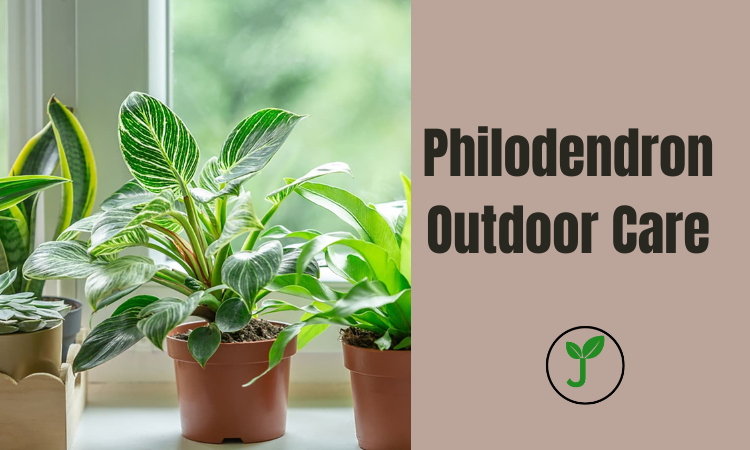Caring for Philodendrons outdoors can be a rewarding experience, especially for plant lovers in the United States. These tropical plants can thrive in your garden with the right conditions and care techniques. In this post, we’ll dive into the details of Philodendron outdoor care, offering tips and tricks from my decade-long experience of growing various Philodendron species. Whether you’re new to gardening or a seasoned pro, you’ll find valuable information here to keep your Philodendrons healthy and thriving. Don’t forget to check out our range of plant care products like pots, pruning shears, and fertilizers at RealJef Shop.
Understanding Philodendrons
What Are Philodendrons?
Philodendrons are a large genus of flowering plants in the Araceae family, native to tropical America. Known for their lush foliage and easy care, they are popular among gardeners both indoors and outdoors.
Types of Philodendrons
Philodendrons come in two main types: climbing (vining) and non-climbing (self-heading). Climbing varieties need support like a trellis or a tree, while non-climbing types grow upright and are perfect for garden beds or large pots.
Essential Outdoor Care Tips for Philodendrons
Choosing the Right Location
Sunlight Requirements
Philodendrons thrive in bright, indirect light. While they can tolerate some morning sun, too much direct sunlight can scorch their leaves. Find a spot in your garden that gets dappled sunlight throughout the day.
Temperature Tolerance
These tropical plants prefer warm temperatures. Ensure they are not exposed to temperatures below 55°F (13°C). If you live in a cooler climate, consider growing them in pots so you can bring them indoors during the colder months.
Soil and Planting
Soil Composition
Philodendrons prefer well-draining soil rich in organic matter. A mix of potting soil, peat moss, and perlite works well to ensure good drainage and aeration.
Planting Technique
Plant your Philodendron at the same depth it was in its pot. Ensure the soil is moist but not waterlogged. Mulch around the base to retain moisture and keep the roots cool.
Watering and Fertilizing
Watering Guidelines
Keep the soil consistently moist but not soggy. Water deeply and allow the top inch of soil to dry out between waterings. During the growing season, you might need to water more frequently.
Fertilizing Tips
Feed your Philodendron with a balanced liquid fertilizer every 4-6 weeks during the growing season (spring and summer). Reduce feeding in the fall and winter when the plant’s growth slows down.
Pruning and Training
Pruning for Health and Shape
Regular pruning helps maintain the shape of your Philodendron and encourages new growth. Remove dead or yellowing leaves and any stems that are overgrowing their space.
Training Climbing Varieties
If you have a climbing Philodendron, provide a support structure like a trellis or a stake. Train the vines to grow around the support, gently tying them as needed.
Common Pests and Problems

Pest Prevention and Control
Philodendrons can be susceptible to pests like aphids, spider mites, and mealybugs. Regularly inspect your plants and treat infestations with insecticidal soap or neem oil.
Dealing with Diseases
Overwatering can lead to root rot, a common problem in Philodendrons. Ensure good drainage and avoid letting the plant sit in water. Leaf spot diseases can be managed by removing affected leaves and improving air circulation around the plant.
Seasonal Care Tips
Winter Care
If you’re in a region with cold winters, bring potted Philodendrons indoors or provide frost protection. Reduce watering and stop fertilizing during the winter months.
Summer Care
In hot summers, ensure your Philodendron receives adequate water. Mulching can help retain moisture and keep the roots cool. Provide shade if the sun is too intense.
Philodendron Outdoor Care Guide
| Care Aspect | Details |
|---|---|
| Sunlight | Bright, indirect light; avoid harsh midday sun. |
| Temperature | Warm temperatures, ideally 55-85°F. |
| Soil | Well-draining, rich in organic matter. |
| Watering | Consistently moist soil; avoid waterlogging. |
| Fertilizing | Balanced liquid fertilizer every 4-6 weeks. |
| Pruning | Remove dead leaves; shape the plant regularly. |
| Pests | Inspect regularly; treat with insecticidal soap. |
| Diseases | Ensure good drainage; remove diseased leaves. |
FAQs
Can Philodendrons survive outside?
Yes, with proper care, Philodendrons can thrive outdoors. Ensure they have the right light, temperature, and soil conditions.
How often should I water my outdoor Philodendron?
Water deeply when the top inch of soil is dry. This may be more frequent during hot weather and less in cooler months.
What should I do if my Philodendron’s leaves turn yellow?
Yellow leaves can be a sign of overwatering or nutrient deficiency. Check your watering habits and consider fertilizing if necessary.
Can Philodendrons tolerate full sun?
While they can handle some morning sun, full midday sun can scorch their leaves. Opt for bright, indirect light instead.
How do I protect my Philodendron in winter?
If you live in a region with cold winters, bring potted Philodendrons indoors or provide frost protection. Reduce watering and stop fertilizing.
What kind of fertilizer is best for Philodendrons?
A balanced liquid fertilizer applied every 4-6 weeks during the growing season works well. Reduce feeding in fall and winter.
Conclusion
Growing Philodendrons outdoors can be a delightful and rewarding experience, especially with the right knowledge and care techniques. By following these guidelines, your Philodendrons can flourish and become a beautiful addition to your garden. Remember to check out our selection of plant care products, including pots, pruning shears, and fertilizers, at RealJef Shop. Happy gardening!
